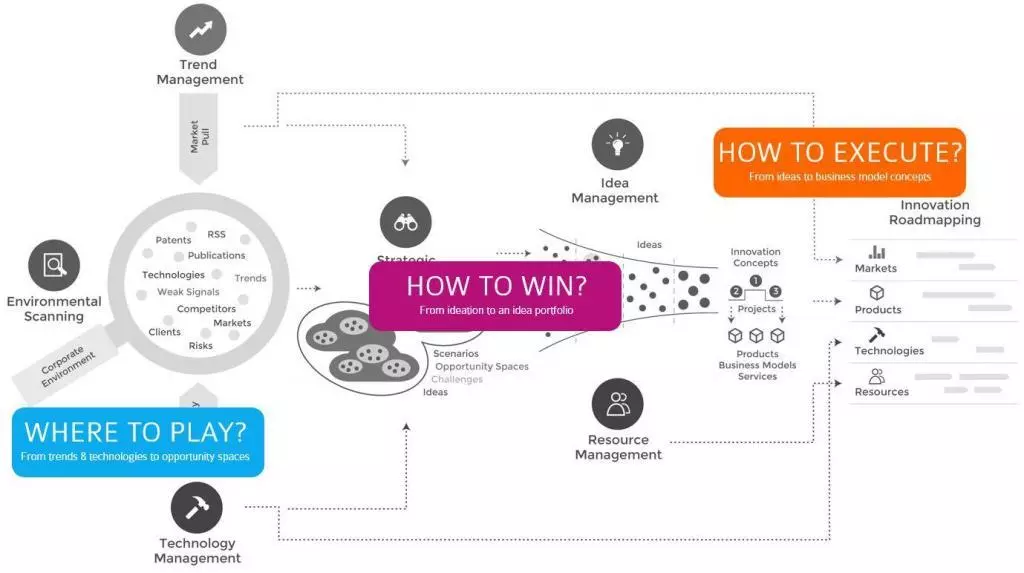Innovation is a central lever in today’s business environment and a buzzword which can cause companies to feel a great deal of uncertainty. Even the most successful brands have to keep up with the rapid pace in order not to be displaced by more dynamic and aggressive companies. But where do you start when the necessary structures in the company are not yet in place?
Based on our long-standing cooperation with international innovation leaders, we have developed a consulting approach consisting of four components using frameworks, methods, and training to establish and encourage successful and holistic innovation management.
→ Free Download: 4 Steps of Systematic Innovation Management
Step 1: Innovation Maturity Assessment – Determining the Maturity Level
Do you know how your company performs in the field of innovation management? How mature is the level of innovation management in your company? Do you have a clearly formulated innovation strategy and dedicated innovation goals? The first step in innovation consulting deals with these questions. Together with the customer, the maturity level and status quo of the existing innovation management in the company is analyzed on the basis of an Innovation Maturity Assessment.
With the help of questions on innovation strategy and objectives, innovation organization and processes, methodological competence, software solutions and the evaluation of innovation success, a personal innovation benchmark and an individually tailored roadmap are set up to show the potentials for an increasing innovation performance.
Step 2: Innovation Framework Set-ups – Creating a framework for Innovation
Once the maturity assessment has been completed, the structural and organizational framework for innovation management is defined. Together with the customer, we develop a framework for future innovation, technology, startup or trend management. Experiences and best practices from other projects in the same industry or similar problems are incorporated. First and foremost, it is about developing a common understanding of innovation and the requirements for innovation management.
The developed frameworks reflect various topics of the front end of innovation. We differentiate between Innovation Management Frameworks, Trend/Technology/Startup Management Frameworks and Roadmapping Frameworks.
Step 3: Innovation Workshops – Bringing Innovation Management to Life
After the structural and organizational anchoring of innovation management, it must be filled with life. Therefore, step 3 of our consulting approach deals with the content and methodological elaboration of innovation management. Our innovation approach focuses on three different areas in order to take a holistic (end-to-end) view on innovation management: Where to play? How to win? How to execute?

Where to play focuses on the identification of trends, technologies or startups that influence the business model.
- Which trends can I currently observe and how do they influence my corporate environment?
- Which new technologies and associated patents are of crucial importance for my company?
- How do established companies and newcomers from different industries use these trends and technologies?
- Which startups mix up my industry or could serve as strategic partners for new technologies?
By linking this information, the threats and opportunities of a company can be uncovered and transferred into so-called opportunity spaces (advantageous innovation fields) as part of the corporate strategy.
The How to win section enables targeted idea development and answers the following questions:
- How do I address my defined fields of innovation within the framework of targeted idea campaigns?
- How do I plan and control my idea campaigns and how do I achieve a high level of participation by the relevant idea providers?
- How do I move from individual ideas to a sustainable idea portfolio?
- Which ideas have the potential to achieve the strategic goals that have been set?
Our idea management approach, therefore, does not begin with a simple collection of ideas, but with targeted idea campaigns. Only by linking defined fields of innovation the strategic orientation and development of qualified ideas can be ensured.
How to execute deals with the further development of ideas with high potential into clear business models:
- What are the detailed concepts behind the most promising ideas?
- Which possible business models are suitable for a successful market launch?
- Does the innovation pipeline contain enough products to serve existing and future markets?
- What internal and external skills and resources do I need to invest in to develop future technologies and products?
By visualizing and contextualizing dependencies between markets, products, technologies and resources in an integrated roadmap across all business units, targeted investment decisions can be made for medium to long-term product and technology planning.
Step 4: Methodical software training – Digitizing Innovation Management
Once the foundations have been laid for holistic innovation management, the individual processes can be supported step by step by software solutions. Digitization in innovation management is becoming more and more popular and raises its performance and professionalism to a whole new level. Especially in the area Where to play, in which a lot of information from different areas is aggregated, processed and evaluated, the corresponding software modules can bring a decisive time and thus competitive advantage.
Software-supported trend and technology scouting, the analysis of patents and publications, the identification of so-called “weak signals” with the help of big data and the analysis of the direct competitor and startup environment play a central role here. Ideation tools enable companies to plan and control targeted idea campaigns and to integrate the relevant idea generators independent of time and place. Using so-called management dashboards, the innovation manager always has an up-to-date overview of the campaigns, the status of the ideas and can thus build up an idea pipeline. By means of a transparent idea portfolio, innovation managers are in a position to turn ideas into groundbreaking products, services or business models.
The market launch of these innovations can then be planned and controlled using a roadmap tool. The transparency of this procedure enables targeted investment decisions and a constant alignment with the corporate strategy.
Measurable success?
One of the most frequently asked questions in collaboration is about measurability. What is the added value and how can the successes achieved be expressed in KPIs? The identified opportunity spaces represent one of the most important indicators. Short and medium-term KPIs can be observed here, for example, the sales volume per identified growth area in relation to market potential or the general number of identified opportunity spaces as well as the number of innovation projects per opportunity space. Cultural factors, such as employee involvement in innovation activities, can also be measured.
In the How to win and How to execute areas, it is particularly important to establish long-term KPIs and critical user metrics for selected innovation concepts and various business cases. Strategic and operative key figures here are, for example, ROII (Return on Innovation Investment), the number of innovation projects carried out and completed, sales growth as well as customer satisfaction through new products or services and general time savings.











